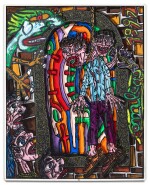
Property from an Important Private Collection
Robert Combas
Autoportrait en crise
Lot Closed
March 9, 01:07 PM GMT
Estimate
60,000 - 90,000 EUR
Lot Details
Description
Robert Combas
n. 1957
Autoportrait en crise
signed and dated 1992
acrylic on canvas
161,5 x 129,5 cm ; 63 9/16 x 51 in.
Executed in 1992.
__________________________________________________________________________
Robert Combas
n. 1957
Autoportrait en crise
signé et daté 1992
acrylique sur toile
161,5 x 129,5 cm ; 63 9/16 x 51 in.
Exécuté en 1992.
Private Collection, France
Tajan, Paris, Contemporary Art, 27 November 2019, Lot 22
Private Collection, Paris
This work brings together the principal aesthetic preoccupations that interested Robert Combas from the early stages of his career. The period of 1984 onwards, in particular, was described by the artist himself as "sophistication", defined by an acceleration of forms and colours in his paintings.
Inspired by the ideals of the Figuration Libre movement, of which he is one of the principal proponents, the artist works in reaction to the artistic currents that emerged in the 1960s - namely conceptual art, geometric abstraction and minimalism - embodying both a formal stripping down and an intellectualisation of the artistic subject.
In response to this aesthetic of extreme purification, Robert Combas delivers this work whose space is saturated, characteristic of horror vacui or ‘the fear of empty spaces’, by graphic and chromatic proliferation. The various forms that punctuate the piece are surrounded by a black or white line and stand out from the background by contrast. The technique used by the artist has the effect of lending the work a vitality as the viewer's gaze is immediately caught by the figurative image.
Combas' work is strongly inspired by urban popular culture and explores hard-hitting societal subjects, imbued with sexual, violent or mythological references. Despite the seemingly naïve and colourful nature of the work, the subject matter here is that of a public lynching: a hanged man is observed by five spectators, including a curious hybrid griffin-like creature in the upper left corner of the composition. This subject is characteristic of another milestone in the artist’s work, the "spiritual in the first degree" period (1988-94) influenced by a medieval aesthetic, an obscure mysticism in which the works are punctuated by the representation of churches, cathedrals, icons and stained glass windows, as is the case here in the background with the stained glass window inscribed in the centre of an archway.
__________________________________________________________________________
Cette œuvre rassemble en son sein les principales préoccupations esthétiques qui ont intéressé Robert Combas dès les balbutiements de sa création, mais plus particulièrement à partir de 1984 dans une période qu’il qualifie de « sophistication », définie par une accélération des formes et des couleurs dans la représentation.
Suivant les idées du courant de la Figuration Libre, dont il est le chef de file, l’artiste entend livrer une œuvre en réaction aux courants artistiques qui ont émergé dans les années 1960 – art conceptuel, abstraction géométrique et minimalisme – incarnant à la fois un dépouillement formel et une intellectualisation du sujet artistique.
En réponse à cette esthétique de l’épuration extrême, Robert Combas livre une œuvre dont l’espace est saturé, caractéristique de l’horror vacui ou angoisse du vide, par la prolifération graphique et chromatique. Les différentes formes qui rythment la représentation sont cernées d’un trait noir ou blanc et se détachent du fond par effet de contraste. La technique employée par l’artiste a pour effet d’apporter vitalité à l’œuvre, le regard du spectateur est immédiatement happé par l’image figurative.
La création de Combas est fortement inspirée par la culture populaire urbaine et explore des sujets sociétaux percutants, empreints de références sexuelles, violentes ou mythologiques. Malgré une œuvre d’apparence naïve et colorée, le sujet abordé ici est celui d’une mise à mort publique, un homme pendu toisé par cinq spectateurs, dont une curieuse créature hybride s’apparentant à un griffon à l’angle gauche supérieur de la composition. Ce sujet est caractéristique d’un autre jalon dans son œuvre, la période « spirituelle au premier degré » (1988-94) influencée par une esthétique moyenâgeuse, un mysticisme obscur dans laquelle les œuvres sont rythmées par la représentation d’églises, de cathédrales, d’icônes et de vitraux comme c’est le cas ici à l’arrière-plan avec le vitrail s’inscrivant au centre d’un arc.
You May Also Like




